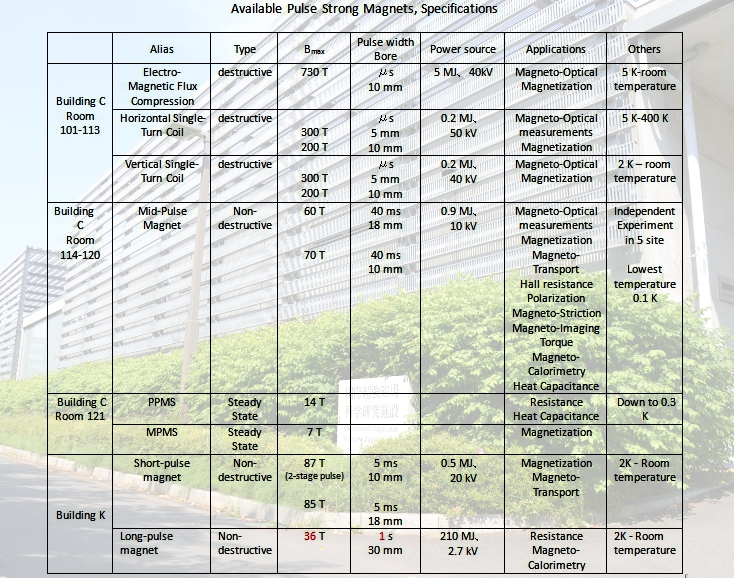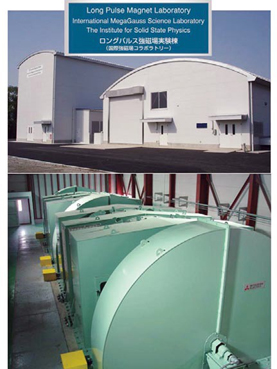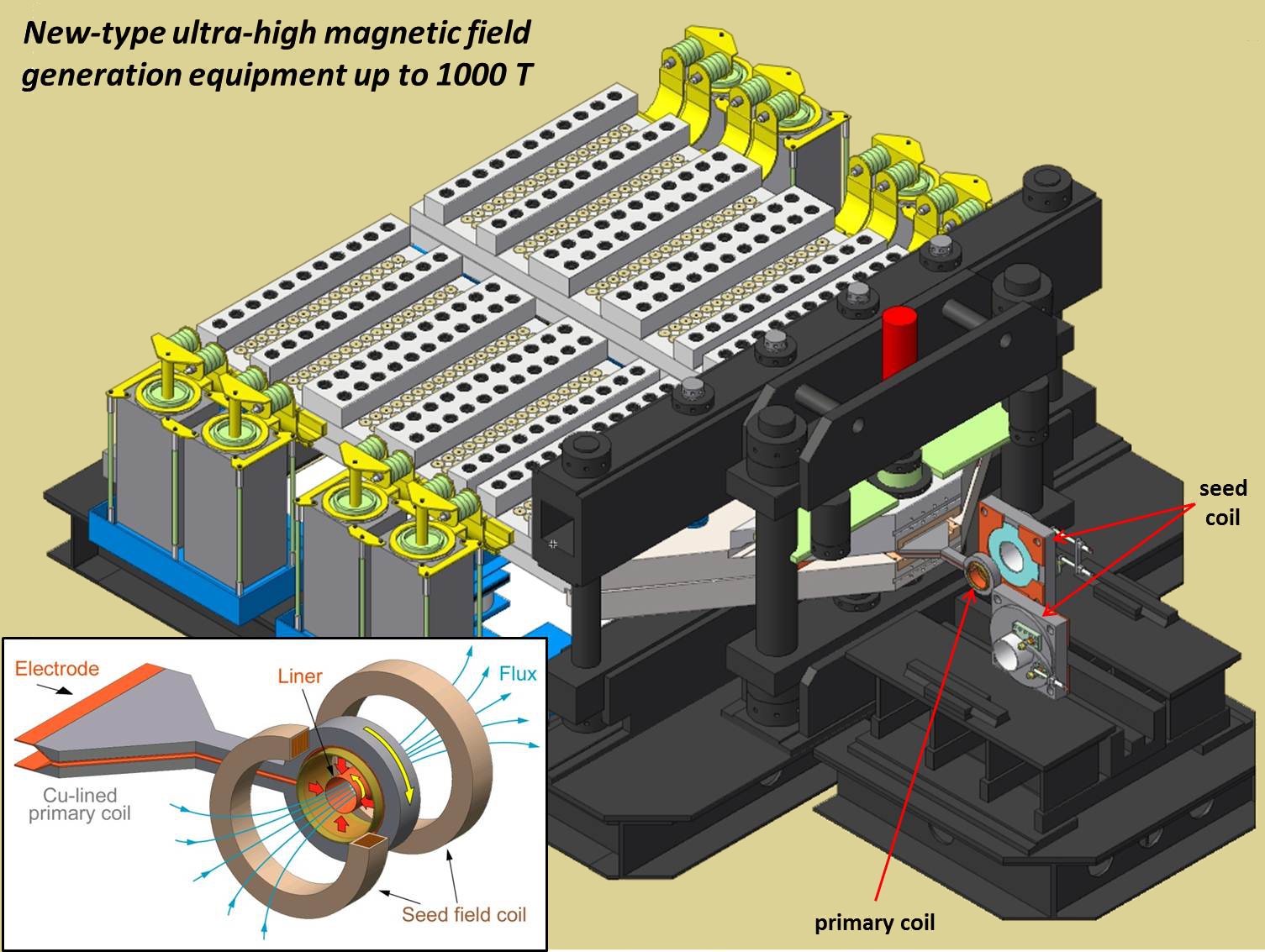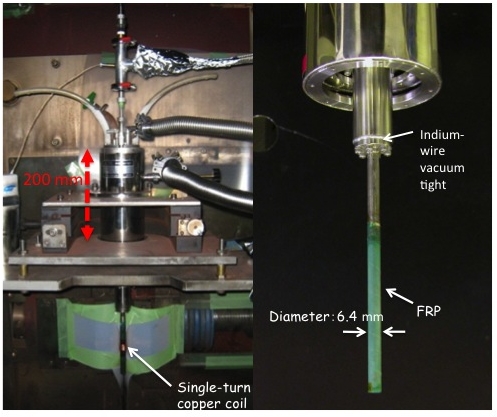
The objective of this laboratory is to study the physical properties of solid-state materials (such as semiconductors, magnetic materials, metals, insulators, superconducting materials) under ultra-high magnetic field conditions. Such a high magnetic field is also used for controlling the new material phase and functions. Our pulse magnets, at moment, can generate up to 87 Tesla (T) by non-destructive manner, and from 100 T up to 760 T (the world strongest as an in-door record) by destructive methods. The laboratory is opened for scientists both from Japan and from overseas, especially from Asian countries, and many fruitful results are expected to come out not only from collaborative research but also from our in-house activities. One of our ultimate goals is to provide the scientific users as our joint research with magnets capable of a 100 T, milli-second long pulses in a non-destructive mode, and to offer versatile physical precision measurements. The available measuring techniques now involve magneto-optical measurements, cyclotron resonance, spin resonance, magnetization, and transport measurements. Recently, specific heat and calorimetric measurements are also possible to carry out with sufficiently high accuracy.
Our standard non-destructive-type pulse magnets are energized by single capacitor bank and can generate fields up to 75 T for ordinary use. Their simple sinusoidal waveforms are advantageous for precise and reliable measurements of various physical properties. Several on-demand magnets having irregular shapes and sizes are developed for some particular experiments. We open six magnet cells for parallel experiments and accept more than 50 research projects per year in 2013.
A 210 MJ flywheel generator (Fig.1), which is the world largest DC power supply (recorded in the Guinness Book of World Records) has been installed in the DC flywheel generator station at our laboratory, and used as an energy source of long pulse magnets. The magnet technologies are intensively devoted to the quasi-steady long pulse magnet (an order of 1-10 sec) energized by the giant DC power supply. The latest long-pulse magnet can generate fields up to 36 T with its pulse half-period of 1 sec.
Our interests cover the study on quantum phase transitions (QPTs) induced by high magnetic fields. Field-induced QPTs have been explored in various materials such as quantum spin systems, strongly correlated electron systems and other magnetic materials. Direct thermodynamic evidences of QPTs are obtained through magnetization and recently developed caloric measurements. For some QPTs, changes in symmetry at the transitions are sensitively resolved through measurements of electric polarization or optical imaging using a polarizing microscope. High resolution of electrical measurements realized the observation of quantum oscillations in high quality crystals through measurements of electrical resistivity, contactless impedance, and torque magnetometry.
Magnetic fields higher than 100 T can only be obtained with destructing a magnet coil, where ultra-high magnetic fields are obtained in a microsecond time scale. Our destructive techniques have undergone intensive developments. The project, financed by the ministry of education, culture, sports, science and technology, is now in progress, and goal is to generate 1000 T by the electromagnetic flux compression (EMFC) system (Fig. 2). The system which is unique to ISSP in the world scale is comprised of a power source of 5 MJ main condenser bank and 2 MJ condenser bank and has been accomplished its installation. Two magnet stations are constructed and both are energized from each power source. Both systems are fed with a 2 MJ condenser bank used for a seed-field coil, of which magnetic flux is to be compressed.
As an easy access to the megagauss science and technology, we have the single-turn coil (STC) system capable of generating the fields of up to 300 T by a fast-capacitor of 200 kJ. We have two STC systems, one is a horizontal type (H-type) and the other is a vertical type (V-type, Fig.3). Various kinds of laser spectroscopy experiments such as the cyclotron resonance and the Faraday rotation using the H-type STC are available. On the other hand, for very low-temperature experiments, a combination of the V-type STC with a liquid helium bath cryostat is very useful and the magnetization measurements at temperature as low as 2 K can be performed up to 120 T with high precision.
 |
Fig. 1. The building for the flywheel generator (left hand side) and a long pulse magnet station (right hand side). The flywheel giant DC generator is 350 ton in weight and 5 m high (bottom). The generator, capable of a 51 MW output power with the energy storage 210 MJ, is planned to energize the long pulse magnet generating 100 T without destruction. |


